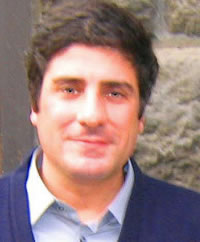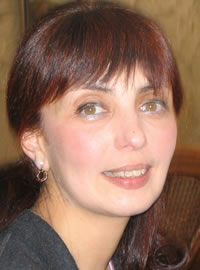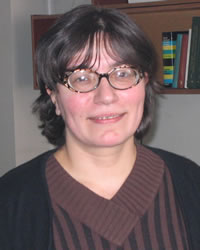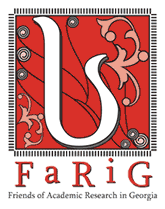Research grants
Dr Marina Alexidze on C18 Georgian Literature
Dr Marina Bulia on C13 murals
Dr Tina Tseradze on a set of Gospels in Church of the Holy Sepulchre
This year FaRiG had a larger amount of money to give out that before, and we decided to give grants of £1,000 to assist scholars in their research. We wanted new research in some subject in which the scholar was interested, and we said that if it was interesting to English-speaking people we would encourage publication in English. We offered the grants to people who were aged between thirty-five and forty-five, since there are number of grants for people under 35, and we wanted people above this age to feel that their scholarly activity was equally valuable.
Dr Nikoloz Vacheishvili

One of the scholars whom the judges chose was Dr Vacheishvili. He is an architectural historian, and is the editor of a new publication called "Georgian Antiquities". His main interst is in the local architecture of Georgia and its relationship with the surrounding countries. But after sending in the application for FaRiG's Research Grant the new Georgian government invited him to beome the Assistant Minister of Culture. As a great friend of all those interested in Georgian Art he is ideally suited to this position, since he can realistically see the results of the decisions of the Ministry of Culture, and how they will affect the future.
As regards FaRiG's Research Grant, he will be far too busy to take it up in the next two years. But by then the situation might have changed, so FaRiG has agreed to make the money available at a later date, should he need it.
In any case, warmest congratulations to Dr Vacheishvili, as he starts to explore his new appointment, and great hopes for success.
Dr Marina Bulia

Marina Bulia is a Senior Researcher in the G. Chubinashvili Institute for the History of Georgian Art. She is an experienced lecturer onthe history of Georgian Art, and her special interest is in medieval mural painting in Georgia. Her previous work was in the Church of the Annunciation, located in the desert of Davi Garedja, where Georgian monks have now lived for 1500 years. She was working on a picture of King Demetre, who was killed by the Mongols in 1289.
Her new research concerns another church in David Gareja with slightly earlier paintings beginning with the reign of Duessn Tamar. She now wishes to discover what was the influence of secular events on these religious paintings.
Dr Marina Alexidze
A subject of increasing interest to her has been the literature of Georgia in the eighteenth century. She has reaslised that in this period the writers grew out of their fascination with the orient and started to attend to the cultures which they came in contact in the west. She is very well equipped to do this work. After studying Oriental languages in Tbilisi University she has spent ten years in the Institute of Oriental Studies under the auspices of the Georgian Academy of Sciences. Since she is using material which is partly in manuscript this should be a great interest both to those interested in literature and also in history.
Dr Tina Tseradze

Dr Tseradze is well acquainted with Jerusalem and the Holy Land, having spent a year there studying and later been there on a new project. In the Holy Sepulchre Church she has discovered a book of the Georgian Four Gospels which has not yet been studied. It is lavishly illustrated by two artists. Dr Tseradze is a member of the K. Kekelidze Institute of Manuscripts, and she is setting out to produce a full account of how this manuscipt came to be produced.
